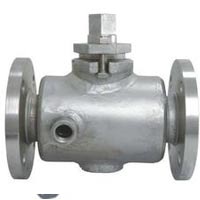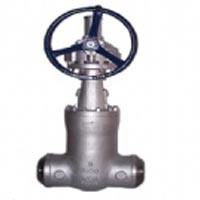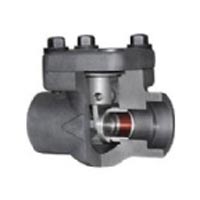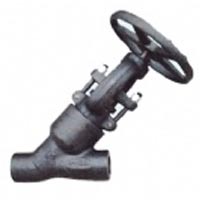Maintenance and maintenance of the valve during use
The valve should pay attention to maintenance and maintenance during use. On the one hand, good maintenance and maintenance can ensure the reliable operation of the valve, and on the other hand, it can effectively extend the service life of the valve.
(1) Cleaning and lubrication of transmission parts
The stem thread is an important part of the valve opening and closing transmission parts. The cleanliness and lubrication of its surface directly affect the normal operation of the valve. Regularly check the cleanliness of the threaded surface of the valve stem, and regularly lubricate the threaded stem with butter, molybdenum disulfide or graphite powder to ensure the reliability of its transmission performance. Even for valves that are not frequently opened and closed, turn the handwheel regularly to add lubricant to the valve stem threads to prevent the threads from seizing.
If the valve adopts mechanical transmission, the condition of the lubricating oil in the bearing box and gearbox should be checked regularly, and the lubricating oil should be added or replaced in time to ensure that the transmission components such as bearings and gears are in good lubrication.
Always keep the valve clean. Especially for valves installed in areas where the external environment is harsh, a protective sleeve should be added to the valve stem to prevent rain, snow, dust, etc. from corroding the valve stem and causing the valve to open and close.
(2) Always check and maintain the integrity of valve components
Especially for valves installed outdoors, necessary protective measures should be taken to avoid long-term exposure of the valve to harsh environments, which may cause corrosion of the valve, which may cause the pressure-bearing boundary to fail and eventually lead to serious consequences.
(3) Check the flexibility of the valve
At present, most valves are equipped with switch indicators. When operating the valve, you should first see the direction of the switch. At the same time, you should not use excessive force at the starting position. The threaded part of the valve stem can be lubricated and maintained with some allowed oil on the pipeline.
(4) Regularly check the stuffing box for leaks
If a slight leakage is found, it can be solved by re-tightening the pressure plate and pressure sleeve, but the pressure plate thread should be symmetrically pressed during the re-compression process to prevent the pressure sleeve from skewing and blocking the valve stem. After the compression process is over, the valve stem should be operated to check the valve performance.
Valve operation
For valves, not only must be able to install and regularly maintain and maintain, but also be able to operate. Under normal circumstances, the opening and closing of the valve follows the principle of “reverse opening and closing”, that is, turning the hand wheel counterclockwise to open the valve, and turning the hand wheel clockwise to close the valve.
(1) Whether it is an electric valve or a pneumatic valve, the manual function is generally considered when designing the valve. The manual function of the valve is generally realized by a hand wheel or a handle. The hand wheel or handle of the valve is designed according to ordinary manpower, taking into account the strength of the sealing surface and the necessary closing force. Therefore, a long lever or a long wrench cannot be used to pull the valve during the actual valve opening and closing operation. Some people are accustomed to using “F”-shaped wrenches, and they should be careful not to use too much force, otherwise it will easily damage the sealing surface, or break the hand wheel or handle. For valves that are partially driven by bevel gears or worm gears, use extensions Use a lever or “F”-shaped wrench to operate the handwheel. Excessive force may cause deformation or damage to the bevel gear or worm gear.
(2) When opening and closing the valve, the force should be steady and no impact. Some parts of high-pressure valves that are opened and closed with an impact handwheel have been designed and manufactured with this impact force taken into consideration, which cannot be equivalent to ordinary valves.
When the valve is fully opened, the handwheel should be turned upside down a little to tighten the threads to avoid loosening and damage. For rising stem valves, remember the position of the valve stem when fully open and fully closed, so as to check whether the valve state is normal when fully open and fully closed. If the valve flap falls off, or the valve core and the sealing surface of the valve seat are more embedded For large debris, the valve stem position will change when fully open and fully closed, and then it will be easy to find faults and take further measures in time.
(3) When the pipeline is first used, there are many impurities inside. You can open the valve slightly, use the high-speed flow of the medium to wash it away, and then close it gently (not fast or abruptly to prevent residual impurities from trapping the seal Face), turn it on again, repeat this many times, flush
Clean the dirt, and then return to normal work.
If the valve is normally open, there may be dirt on the sealing surface. When it is closed, it must be flushed clean with the above method, and then formally closed. If the hand wheel and handle are damaged or lost, they should be equipped immediately, and the adjustable wrench can not be used to replace it, so as to avoid damage to the valve stem and failure of opening and closing, resulting in accidents in production.
Some media cool down after the valve is closed, causing the valve to shrink. The operator should close it again at an appropriate time. (4) Keep the sealing surface without any crevices, otherwise, the medium will flow through the crevices at a high speed and it will be easily eroded Sealing surface.
(5) When operating the valve, if the operation is found to be too laborious, the reason should be analyzed and the operation cannot be forced. If the packing is too tight, loosen it appropriately; if the valve stem is skewed, notify the maintenance personnel for repair. For high-temperature gate valves, when closed, the closing part is heated and expands, causing difficulty in opening. If it must be opened at this time, loosen the bearing gland on the valve cover by half a turn to one turn to eliminate the stress on the valve stem, and then turn the handwheel .
(6) When operating the high-pressure valve, because the pipeline pressure of the high-pressure valve is very high, the pressure difference between the front and rear of the valve is very large when driving, so the operation must be very careful, and the opening must be slowly and gradually opened. Open a little bit first, so that the high-pressure fluid slowly fills the pipeline behind the valve. When the front and rear pressures are close, adjust the valve opening according to the specified flow. If the system has a bypass valve, open the bypass valve before opening the main valve. When the front and back pressures are close to balance, then open the large high-pressure valve on the main pipeline.
(7) Wedge gate valves and globe valves are only used for fully open or fully closed, and are not allowed to be used for adjustment and throttling, so as to avoid erosion and cause seal failure or shorten valve service life.
The role of control valves in industrial production process control
Basic composition of control system (1) Manual control Take the liquid level control shown in Figure 1-1 as an example







